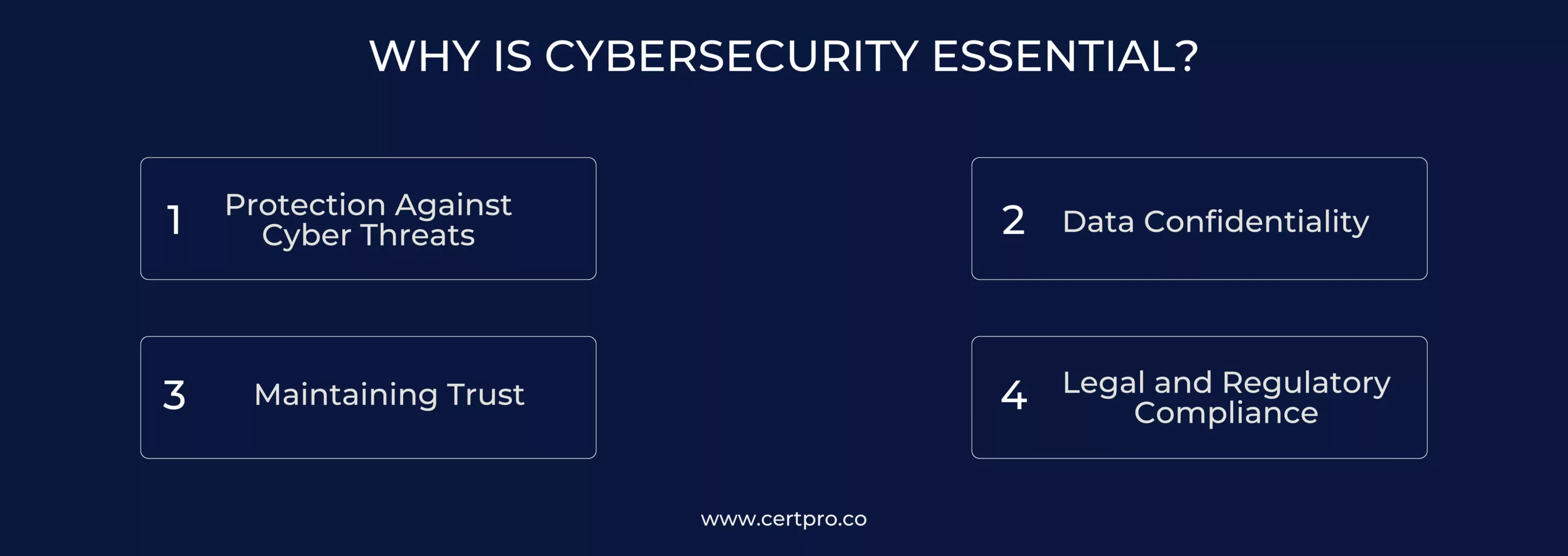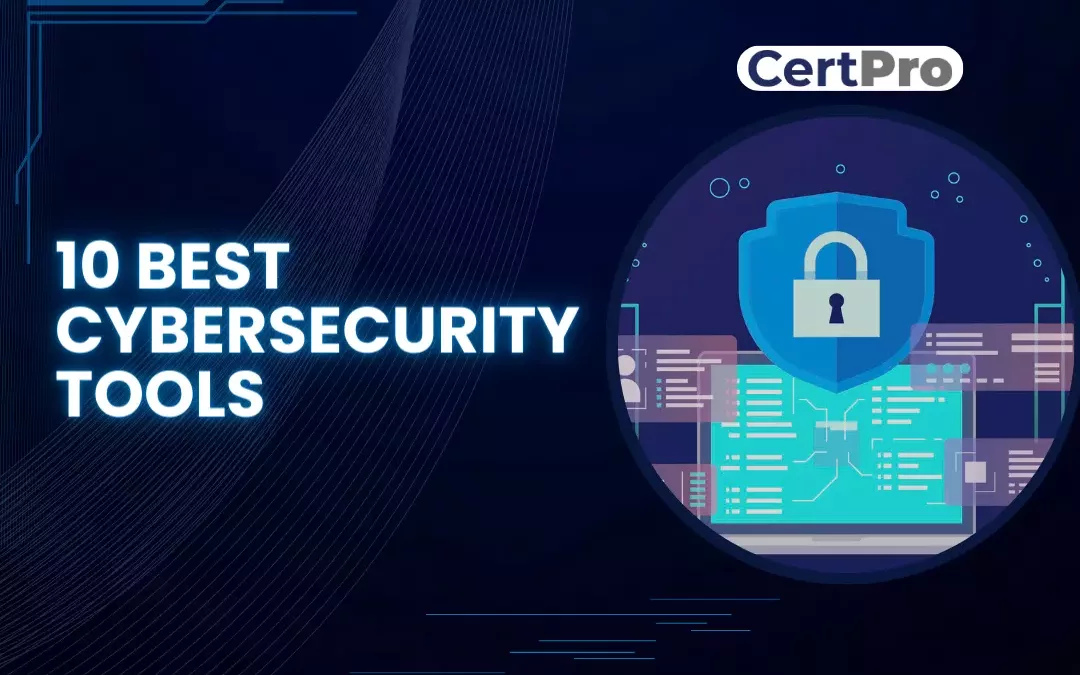In today’s interconnected digital environment, the importance of cybersecurity has reached unparalleled heights. The growing sophistication of cyber threats emphasizes the urgent need for effective cybersecurity tools. This blog article will methodically investigate the key principles inherent in cybersecurity tools, providing light on their important role in bolstering our digital realm’s defenses. Beyond a quick review, we hope to unearth the complex value of these tools, investigate the wide range of types available, and highlight the top 10 cybersecurity tools poised to reshape the landscape in 2024.
Understanding the several advantages of effective cybersecurity is critical. As we traverse this changing digital landscape, the investigation goes beyond enumeration, diving into the fundamental benefits that skilled cybersecurity provides to individuals and companies alike. As cyber dangers continue to evolve and expand, a complete understanding of these technologies requires more than just a defensive strategy for navigating the changing digital world.
The purpose of this article is to offer readers a complete grasp of the numerous benefits that come with using the most recent technologies, as well as information about them. Effective cybersecurity is becoming increasingly important for both consumers and businesses because it may avoid potential breaches and improve the trust that is necessary for the global digital paradigm. Essentially, the purpose of this inquiry is to offer readers a comprehensive understanding, encouraging a secure and robust digital future.
WHY IS CYBERSECURITY ESSENTIAL?
In this digital age, cybersecurity is fundamental because it protects sensitive data and acts as a key line of defense against a variety of cyberthreats. The importance of it in building relationships, protecting privacy, and upholding the law is emphasized in this synopsis. By illuminating the many types of cybersecurity tools and their basic advantages, the conversation delves into the complex facets of cybersecurity. In general, the emphasis is on revealing the various facets of cybersecurity’s significance in building a safe, reliable, and legally compliant digital environment.
1. Protection Against Cyber Threats: Cybersecurity technologies, which act as a formidable barrier, are critical in guarding against a wide range of threats such as malware, phishing assaults, and ransomware. These solutions serve as a safeguard, protecting digital systems and sensitive data against unwanted access and potential breaches. They are critical because they can actively detect and mitigate numerous cyber threats, ensuring the protection of digital assets in an ever-changing online environment.
2. Data Confidentiality: These techniques go beyond simply protecting sensitive data from unauthorized access to establish an impenetrable barrier against possible intrusions. These cybersecurity procedures ensure the confidentiality of important information by applying advanced encryption methods and access controls. This proactive strategy not only protects against unauthorized access but also fosters trust, which is critical for individuals and organizations charged with protecting important and personal data in an increasingly interconnected digital environment.
3. Maintaining Trust: In a digital age where trust is the foundation of all interactions, cybersecurity technologies play a critical role in instilling trust in users, customers, and stakeholders. These tools maintain the integrity and security of digital transactions and engagements through their comprehensive protection mechanisms. By safeguarding confidential data and thwarting cyberattacks, they create a safe atmosphere for online transactions, which aids in the growth and preservation of confidence in the networked digital world.
4. Legal and Regulatory Compliance: Legal and regulatory frameworks usually require compliance with cybersecurity measures, pushing firms to agree with industry norms and avoid significant penalties. This adherence is not only a suggestion; it is a legal requirement. Organizations that adhere to established cybersecurity rules not only avoid legal concerns but also contribute to the overall resilience of the digital ecosystem. This compliance commitment ensures a proactive approach to cyber risk management, following industry standards, and protecting against potential legal ramifications.

THE NEED FOR CYBERSECURITY TOOLS
The increasing frequency and complexity of cyber threats offer a crucial problem for global enterprises in today’s digital landscape. Key considerations highlight the critical necessity for a strong cybersecurity architecture. Proactive defense against the ever-increasing number of cyber attacks is critical, making improved cybersecurity tools essential. These tools are critical in protecting data, preventing illegal access, and limiting hazards. In the face of emerging cyber threats, establishing a comprehensive cybersecurity infrastructure has become critical for protecting the security and integrity of corporate assets.
1. Rising Cyber Threats: The increased frequency and complexity of cyber threats such as malware, ransomware, and phishing assaults emphasizes the critical need for cybersecurity technologies. These technologies are critical for identifying, avoiding, and mitigating developing threats, assuring effective system and data defense in the face of a growing digital risk landscape.
2. Data Protection: Organizations entrusted with sensitive data such as customer information, financial records, and intellectual property rely on cybersecurity measures to protect against unwanted access. The major objective of these technologies is to guarantee the confidentiality and integrity of essential data, function as a vital defense against potential breaches, and maintain customer and stakeholder confidence and privacy.
3. Business Continuity: Cybersecurity technologies are essential for avoiding, detecting, and recovering from cyber attacks that have the ability to interrupt corporate operations, resulting in financial losses and reputational harm. Their position is critical in providing operational resilience, mitigating the impact of attacks, and protecting businesses’ financial stability and reputation in the face of growing cyber threats.
4. Regulatory Compliance: Governments and business regulators impose stringent data protection and cybersecurity regulations. Organizations rely on cybersecurity solutions to deploy security measures such as encryption and access controls in order to comply with these rules. These technologies not only help with compliance, but they also improve data security by protecting critical information from unwanted access. In essence, cybersecurity technologies are critical to ensuring that enterprises have a safe and compliant working environment.
5. Global Connectivity Challenges: Organizations are vulnerable to global cyber threats in an era of growing internet connectivity. Cybersecurity tools are critical defense mechanisms, providing protection from attacks all over the world and ensuring the construction of a safe digital environment. These tools are critical in minimizing the problems posed by the digital landscape’s linked nature and improving overall resilience against global cyber threats.
TOP TEN CYBERSECURITY SOFTWARE
In the era of technological advancement, the need for strong cybersecurity technologies is critical. Organizations need to arm themselves with cutting-edge technologies to protect sensitive data as cyber threats change. The top 10 types of cybersecurity tools are included in this blog, acting as watchful guardians against the ever-expanding world of online threats. Investigate these state-of-the-art safeguards to strengthen your digital infrastructure and confidently traverse the ever-changing cybersecurity terrain.
1. Kali Linux:
Among the most popular and easily accessible cybersecurity tools is Kali Linux. With more than 300 tools in its arsenal, it gives businesses the capacity to thoroughly evaluate the vulnerabilities in their networking systems. Professionals with varying degrees of experience can customize it due to its versatility, which is a key advantage.
Key Features:
- Cross-Platform Compatibility: Kali Linux ensures compatibility across a variety of devices and environments, providing versatility in cybersecurity operations.
- Open-Source Architecture: As an open-source product, Kali Linux facilitates easy integration and customization, empowering users to tailor the platform to their specific needs.
- Specialization in Security Auditing and Penetration Testing: The tool excels in security auditing, with a particular focus on penetration testing, making it a valuable asset for identifying and addressing vulnerabilities.
2. Aircrack-ng:
An essential open-source tool for assessing the security of Wi-Fi networks is Aircrack-ng, which is a full suite of wireless applications. Its main advantages are that it can be used to construct access point spoofing, crack complex Wi-Fi passwords, and monitor, analyze, and export data packets.
Key Features:
- Seamless Integration with Open-Source Architecture: Aircrack-ng effortlessly integrates with open-source frameworks, allowing for easy adaptability and customization.
- Platform Versatility: While designed primarily for Linux, Aircrack-ng extends compatibility to FreeBSD, macOS, OpenBSD, NetBSD, Windows, Solaris, and even eComStation 2, ensuring accessibility across a variety of operating systems.
- Compatibility with Wireless Network Interface Controllers: It is compatible with a broad range of wireless network interface controllers, enhancing its usability across diverse hardware.
3. Burp Suite:
Burp Suite is a powerful cybersecurity solution that helps enterprises perform real-time scans, which improves network security. Experts in security use Burp Suite to find important security flaws and simulate assaults to evaluate possible vulnerabilities and compromises in network security.
Key Features:
- Three Versions: Burp Suite provides three versions: Community (free with basic tools), Professional, and Enterprise (commercial use). The Community version offers essential manual tools, while the paid Professional and Enterprise versions are favored for their extensive security features.
- Real-Time Scanning: Security experts leverage Burp Suite for conducting real-time scans, a critical aspect of identifying and addressing vulnerabilities promptly to enhance overall security.
- Commercial Viability: Despite potential costs, especially for smaller companies, Burp Suite remains a top choice for organizations due to its recognized effectiveness in bolstering cybersecurity measures.
4. Nmap:
Commonly referred to as Network Mapper, this cybersecurity tool is a free and open-source solution used in the field of cybersecurity to scan IT systems and networks for the identification of security vulnerabilities. Additionally, it empowers professionals to track host uptime, chart potential areas of network and service attacks, and implement crucial security measures accordingly.
Key Features:
- Free and Open-Source: Nmap is freely available and open-source, allowing users to access and modify its source code, promoting transparency and customization.
- Security Vulnerability Detection: Nmap specializes in scanning systems and networks to identify potential security vulnerabilities, aiding in proactive threat mitigation.
- Customizable Security Measures: Nmap provides flexibility for professionals to implement tailored security measures based on the identified vulnerabilities and potential threats.
5. POf:
Even after the most current developer improvements, POf remains a popular cybersecurity tool that makes it easier to continuously monitor networks. Effective network security can be achieved with this tool since it functions well without causing extra data traffic. The host operating systems in a network can be seen with POf, which is mostly used by experts.
Key Features:
- Continuous Network Monitoring: POf enables seamless network monitoring, providing companies with consistent cybersecurity oversight regardless of recent developer updates.
- Low Impact on Data Traffic: One of its strengths lies in its ability to operate without generating extra data traffic, ensuring efficient network security practices.
- Diverse Functionality Set: Cybersecurity experts leverage POf for various functionalities, including name lookups, assorted queries, and probes, enhancing its versatility for in-depth network analysis.
6. Nikoto:
The open-source cybersecurity application Nikto is a top choice for locating and fixing online vulnerabilities. It carries out exhaustive scans to identify possible problems with web apps and offers fixes to improve security.
Key Features:
- Web Vulnerability Detection: Nikto excels at scanning web applications, meticulously identifying vulnerabilities that could pose security risks.
- Thorough Scanning Capability: With its comprehensive scanning capabilities, Nikto thoroughly assesses web systems, leaving no stone unturned in the quest for potential vulnerabilities.
- Suggested Fixes: In addition to detection, Nikto goes a step further by providing recommended solutions to address identified vulnerabilities, assisting in effective security remediation.
7. Forcepoint:
Network and security managers frequently use Forcepoint to customize SD-WAN and make sure that only authorized users have access to particular resource contents. It assists in keeping an eye on malevolent activity occurring within the network, allowing administrators to monitor and proactively resolve security issues.
Key Features:
- Customized SD-WAN: Forcepoint allows administrators to tailor SD-WAN settings, restricting access to specific resource contents solely to authorized users.
- Control Implementation: Users can enhance network security by implementing controls and compliance measures based on insights gained from monitoring malicious activities.
- Cloud Security Alerts: In cloud deployment, Forcepoint issues warnings or blocks cloud servers presenting security threats, enhancing security management, particularly for remote workers.
8. Wireshark:
The open-source console-based program Wireshark is an essential tool for network protocol analysis. By continuously capturing and analyzing data packets, cybersecurity experts use Wireshark to assess network security flaws.
Key Features:
- Open-Source Console Tool: Wireshark is an open-source, console-based tool, providing users with transparency and accessibility to its source code.
- Data Packet Analysis: Cybersecurity experts utilize Wireshark to analyze data packets, enabling the identification of security weaknesses and potential threats within the network.
- Network Protocol Analysis: It specializes in the thorough analysis of network protocols, allowing cybersecurity professionals to gain insights into the intricacies of data transmission.
9. John the Ripper:
A password testing program called John the Ripper is used to assess the strength of passwords. It aggressively finds and examines weak passwords in order to identify any security holes in a company’s firewall.
Key Features:
- Password Strength Testing: John the Ripper specializes in testing the strength of passwords, aiding organizations in fortifying their security by identifying and addressing weak password vulnerabilities.
- Identification of Weak Passwords: The tool actively accesses and identifies weak passwords, offering insights into potential security threats that could compromise the integrity of a system.
- Security Threat Mitigation: By detecting weak passwords, John the Ripper enables organizations to implement necessary measures to mitigate security threats, enhancing overall system protection.
10. Snort:
Renowned for its ability to identify and prevent intrusions in real-time, Snort is an open-source intrusion detection and prevention system. It adapts to different attack scenarios by proactively identifying and responding to security risks through protocol analysis and signature-based techniques. This adaptable tool is extensively used in a variety of scenarios, which makes it crucial for improving network security in a variety of contexts.
Key Features:
- Password Strength Assessment: John the Ripper excels in evaluating password strength, providing organizations with a robust tool for fortifying security by pinpointing and addressing weak password vulnerabilities.
- The tool actively scans and identifies weak passwords, offering valuable insights into potential security threats that might compromise the integrity of a system.
- Effective Security Threat Mitigation:By detecting weak passwords, John the Ripper empowers organizations to implement necessary measures, proactively mitigating security threats and enhancing the overall protection of their systems.
FAQ
How do cybersecurity tools ensure data confidentiality and integrity?
Beyond preventing unauthorized access, cybersecurity tools establish an impenetrable barrier against potential intrusions. They ensure data confidentiality through advanced encryption methods and access controls, fostering trust in an interconnected digital environment.
How can GRC tools help organizations minimize legal and regulatory risks?
Organizations can adhere to regulations by proactively using GRC methods, thus preventing risks and expenses linked to legal non-compliance.
How do cybersecurity tools contribute to legal and regulatory compliance?
Legal and regulatory frameworks often mandate cybersecurity measures. Organizations adhering to these rules not only avoid legal concerns but also enhance the overall resilience of the digital ecosystem. Compliance ensures a proactive approach to cyber risk management.
How do cybersecurity tools contribute to business continuity?
Cybersecurity tools are crucial for avoiding, detecting, and recovering from cyber attacks that can disrupt corporate operations. They provide operational resilience, mitigate the impact of attacks, and protect businesses’ financial stability and reputation in the face of growing cyber threats.
How do cybersecurity tools contribute to password strength assessment and overall system protection?
Tools like John the Ripper specialize in assessing password strength, identifying weak passwords, and mitigating security threats. By actively scanning and addressing weak passwords, these tools enhance overall system protection, fortifying security measures against potential vulnerabilities.

About the Author
MOHAMMAD YASIN
Mohammad Yasin, Regional Manager in Jordan, is a cybersecurity specialist. With a dedicated focus on securing digital landscapes, he brings extensive experience in compliance and strategic cybersecurity measures to the forefront.
HOW DOES THE NIST CYBERSECURITY FRAMEWORK FUNCTION, AND WHY IS IT IMPORTANT?
Emerging cyber threats make cybersecurity an essential consideration for organizations handling and managing data. In this regard, the NIST cybersecurity framework applies to improving your cybersecurity program. It is a set of guidelines that helps improve your...
UNDERSTANDING ISO 42001: A GUIDE FOR RESPONSIBLE AI MANAGEMENT SYSTEMS
The invention of artificial intelligence (AI) has changed the operational processes of many industries. However, the rapid growth of technology increases ethical, security, and privacy-related concerns. Therefore, the International Organization for Standardization...
EUROPEAN UNION’S ARTIFICIAL INTELLIGENCE ACT: HOW THIS GROUNDBREAKING LAW AFFECTS YOUR BUSINESS
Nowadays, Artificial Intelligence (AI) is transforming our lives exceptionally well. AI is now streamlining healthcare services, providing virtual assistance, and fulfilling queries. Technologies have boons and curses. Similarly, AI creates many concerns about...




